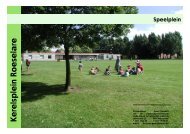Housing First - Provincie West-Vlaanderen
Housing First - Provincie West-Vlaanderen
Housing First - Provincie West-Vlaanderen
Create successful ePaper yourself
Turn your PDF publications into a flip-book with our unique Google optimized e-Paper software.
<strong>Housing</strong> <strong>First</strong>in this sense has been presented as a threat tounconditional shelter in France that could lead toincreases in homelessness in Paris and other cities.However, this argument assumes that <strong>Housing</strong> <strong>First</strong>would ‘replace’ all other forms of homelessnessservice. This would not be the case if something likethe American or Finnish approach to <strong>Housing</strong> <strong>First</strong>were followed in France, where <strong>Housing</strong> <strong>First</strong> isjust one type of the several forms of homelessnessservices, including homelessness prevention, whichare used.It is also worth noting that <strong>Housing</strong> <strong>First</strong> could havea beneficial effect in increasing the capacity ofhomelessness shelters and daycentres in France.Adopting a <strong>Housing</strong> <strong>First</strong> approach does not meanabandoning existing services where there is a needfor them. In the USA, a key argument for <strong>Housing</strong><strong>First</strong> has been that it reduces the use of homelessnessshelters significantly. This was because it was foundthat chronically homeless people, while representingperhaps 10% of all homeless people, stayed inshelters for so long that they used 50% of the bedsthat were available during the course of a year (i.e.each chronically homeless person used a bed inhomeless shelter many times, meaning it could notbe used by other homeless people). As <strong>Housing</strong> <strong>First</strong>services took chronically homeless people out of theshelter system, those beds became available again.Over time, it is true that it was hoped that somereductions on spending on shelters could occur inthe USA, as fewer beds would be needed overalldue to <strong>Housing</strong> <strong>First</strong>. In France, <strong>Housing</strong> <strong>First</strong> mightbe used to allow shelters to better meet the needs ofthose who are homeless and are unable to accesshousing immediately, such as migrants that facebarriers due to their legal or administrative status.Why use <strong>Housing</strong> <strong>First</strong>in France?There are three main reasons to consider using<strong>Housing</strong> <strong>First</strong> services in France.❱❱The core philosophy of <strong>Housing</strong> <strong>First</strong> is thereason for the success that has been achievedin delivering stable housing and accommodationfor formerly chronically homeless people. The<strong>Housing</strong> <strong>First</strong> philosophy can be drawn uponwithout copying the detailed operation of <strong>Housing</strong><strong>First</strong> services working in the USA. The ideas of<strong>Housing</strong> <strong>First</strong> can be used to design services thatcan be used to reduce chronic and other formshomelessness in different countries with differentwelfare systems. An example of this has been theuse of the <strong>Housing</strong> <strong>First</strong> philosophy to effectivelyredesign homelessness services in Finland.❱❱<strong>Housing</strong> <strong>First</strong> is highly flexible. The corephilosophy has been adapted from the Pathways<strong>Housing</strong> <strong>First</strong> (PHF) model and employed inCommunal <strong>Housing</strong> <strong>First</strong> (CHF) and <strong>Housing</strong><strong>First</strong> Light (HFL) services that can be focused onboth chronic homelessness and on other formsof homelessness.❱❱<strong>Housing</strong> <strong>First</strong> services can support other types ofhomelessness services, for example by stoppingvery long stays in emergency accommodationbeds by homeless people that could accesspermanent housing. It is important to note that<strong>Housing</strong> <strong>First</strong> is not designed to replace allexisting homelessness services and has beenused as one part of a mixture of services torespond to homelessness in the USA and Finland.By supporting the work of other homelessnessservices, <strong>Housing</strong> <strong>First</strong> services can potentiallyenhance the capacity of the overall homelessservice provision and ensure that the needs ofdiverse groups within the homeless populationare met.It is important to end this discussion with a noteof caution. <strong>Housing</strong> <strong>First</strong> services are effective ifthey follow the harm reduction approach and othercore elements of the <strong>Housing</strong> <strong>First</strong> philosophy. Aservice is not ‘<strong>Housing</strong> <strong>First</strong>’ if it adopts some ofthe core elements of this philosophy and not others.For example a service that gives immediate accessto housing and uses mobile support services, butwhich requires abstinence from drugs and alcoholis not a <strong>Housing</strong> <strong>First</strong> service. Similarly, a servicethat requires chronically homeless people or otherhomeless people to complete one or more steps in aprogramme to make them ‘ready for housing’, beforegranting access to secure housing is still followinga staircase model, it is not <strong>Housing</strong> <strong>First</strong>. Adoptionof the core philosophy of <strong>Housing</strong> <strong>First</strong> cannot bepartial. Although there is some scope for flexibility,immediate access to housing, the separationof housing and support and a harm reductionapproach are crucial elements of the <strong>Housing</strong> <strong>First</strong>philosophy and of the effectiveness of the approach.This core philosophy can be adapted to a range ofoperational contexts and service delivery models butthe key principals must be addressed in order toend situations of homelessness.45
















